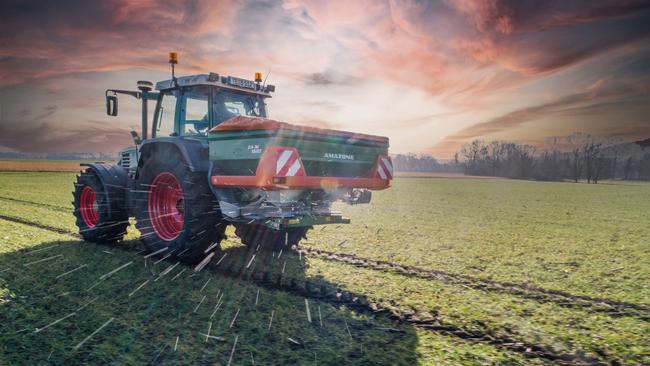Australian fertiliser prices set to rise
Surging fertiliser prices caused by global factors could further impact Aussie farmer’s wallets before too long.

Prices Australian grain and livestock farmers will need to pay for the key fertiliser products used are predicted to head north of $1000/tonne this coming month.
This follows an extraordinary rally in the costs of the crucial input, driven by soaring global energy costs, and disruptions to supply chains caused by everything from hurricanes to political interventions.
New modelling shows the spot imported fertiliser price for the coming month, loaded at port, for Urea could be as high as $958/tonne, with costs taking that to around a $1058/tonne grower price.
And for the key phosphorus fertiliser DAP, pricing is similar, with modelling showing spot import prices for this product at $950/tonne, or around $1050/tonne for the grower price, inclusive of unloading, logistic and administration costs.
Urea prices have risen most rapidly in the past year.
In October 2020 Urea was priced at around $393/tonne, moving to $513/tonne in May of this year.
DAP prices have not risen as swiftly, going from $522/tonne last October to $748/tonne this May.
Thomas Elder Markets analyst Andrew Whitelaw said DAP and Urea were the most-commonly used fertiliser products in Australia, and most of the DAP — around 65 per cent of it, and of the similar product MAP — came from Chinese fertiliser plants, while Urea was mainly sourced from the Middle East.
“There are a whole host of factors influencing prices; but the first is energy costs which have risen at an even faster rate than fertilisers,” Mr Whitelaw said.
Gas prices in Europe, for example, had risen per unit from around 19 euros to 100 euros this year.
Energy shortages and high gas and coal prices had even lead to some fertiliser plants in the United Kingdom and Europe being shutdown due to the high costs.
Meanwhile, China had gradually ramped up its restrictions on fertiliser exports, in a bid to lower the cost for its own farmers.
China’s “unofficial ban on Australian coal” had led to unreliable electricity supplies, Mr Whitelaw said, also hampering fertiliser production.
Hurricane Ida in the Gulf of Mexico had also damaged fertiliser production infrastructure in that region in August, he said, but that was being rectified.
On a global level, China accounted for about 25 per cent of global trade of MAP in the past five years, and on average, 50 per cent of globally traded DAP.
Therefore moves by China to stop exporting fertiliser were expected to have major implications on the global pricing and availability of the key farming input.
On Urea, Australia had less reliance on China, sourcing around 14 per cent of its total imports from that country. In 2018 Australia imported 95,000 tonnes of urea from China, from a total import pool of 1.7m tonnes.
In 2019, 240,000 tonnes came from China, from a total import tonnage of 1.9m tonnes.
Australia was also building two new Urea plants — Leigh Creek Energy in South Australia and another planned in Western Australia by Strike Energy, Mr Whitelaw said.
Now, most Urea was imported from Saudi Arabia and other Middle Eastern nations. Alternative sources of DAP and MAP were local Australian producers, as well as plants in the US, Morocco and Mexico — but it all came down to price, he said, and China had been favoured due to its more competitive rates.
Looking ahead, Mr Whitelaw said there was “no point trying to guess as nobody knows” what prices could do leading up to winter crop sowing.
However, he said it appeared like prices would be even higher than the $1000/tonne rates now forecast for the coming month.
“The concern really for farmers is the cost-price squeeze on inputs and outputs,” he said.
“It is a question of whether they can still make money.”
Mr Whitelaw said it would be likely that fertiliser would be available, but “at what price”.
He said gas and coal derived energy costs could be pushed higher in the longer-term.
As the world transitioned towards renewables, Mr Whitelaw said higher fertiliser prices could be seen, as coal and gas was moved away from production, unless alternatives were found, which was likely in plans for 10 years and beyond.
“The world isn’t completely ready for the renewable (energy) environment and as far as I’m aware there are not any renewable energy driven fertiliser plants — if it was profitable to do it, someone would,” he said.
All of this pointed to higher input costs for farmers and a greater squeeze on the profitability of farming enterprises.
“It could lead to the rationing of fertiliser use,” Mr Whitelaw said, which could then drive down yields, leading to impacts on global food supplies.
Third World countries could bare the brunt of rising food prices, as a result, he said.
“It has to be a balancing act — the move towards renewable and ‘green’ energy and the impact that this will have on (global) food production,” Mr Whitelaw said.
Locally, a recent investigation released by ABARES, reviewing 20 years of farm profitability in Australia found that in real terms, the profitability of farming, as a ratio to the costs of the assets required for it, continued to fall as factors like rising input costs curb how much money farmers can make from farming land.
The statistics come from a major benchmarking study surveying 37,000 livestock farmers across Australia, conducted by ABARES in conjunction with Meat and Livestock Australia.
The study reveals pointed to improved returns for livestock producers across much of Australia, but, declining returns on assets managed over the two decade period.
A large factor in this was rising property prices which are often getting out of step with the land’s ability run enterprises profitable enough to service the cost of land — the productive capacity of farmland.




